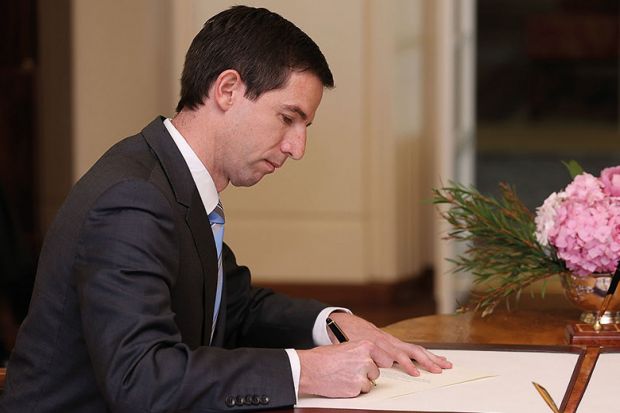The Australian government’s plan to cut university funding by 2.5 per cent and increase tuition fees by 7.5 per cent is “benign” compared with earlier radical proposals, according to the architect of the country’s student loans system.
Proposals unveiled by Simon Birmingham, education minister in the Liberal-led government, would also see students forced to repay their loans once they earn A$42,000 (£24,267) a year, down from the current threshold of A$55,874.
The fee rises, once fully implemented in 2021, would result in an increase in total student fees for a four-year course of between A$2,000 and A$3,600.
The government said the changes would mean graduates paying 46 per cent of the cost of their degree on average – up from the present 42 per cent – with public funding accounting for the remainder.
The 2.5 per cent funding cut will be delivered via an “efficiency dividend” on teaching funding in 2018 and 2019. And, by 2018, 7.5 per cent of a university’s teaching funding “will be contingent on the university meeting performance requirements”, the government says.
The package, which will need to win backing in Parliament to come into force, could bring an end to a university funding saga that began in 2014, when the government then led by Tony Abbott announced plans to cut sector funding by 20 per cent and to uncap fees to compensate.
The government of his successor, Malcolm Turnbull, later abandoned the fee deregulation plans after they were voted down in the Senate, Parliament’s upper house. But the 20 per cent cut had remained on the government’s books until now.
Bruce Chapman, the Australian National University professor of economics who designed the nation’s original system of income-contingent loans, said that this week’s changes were nothing like the “radical, kind of stunning, policy announcement” of 2014 or England’s trebling of fees to £9,000 in 2012.
“In that context, this is kind of conservative: not touching things much, raising a bit of money [to address the budget deficit], not doing anything to upset the essence of the policy template,” he added.
Professor Chapman, emphasising the removal of the 20 per cent cut, said: “If you were looking for one word to describe all this I would say ‘benign’. If you were looking for three words I would say ‘conservative and benign’.”
Andrew Norton, higher education programme director at the Grattan Institute thinktank, said that the increases in student contributions and corresponding decreases in public funding “do not change the longstanding public-private hybrid model of financing Australian higher education. Student charges remain capped.”
Hamish Coates, professor of higher education at the University of Melbourne, said the changes were “as much a nod in the direction of political compromise and passage through the Senate”, where the government does not have a majority, as about higher education funding reform.
Mr Birmingham has indicated that the performance measures will link a portion of university funding to success in completion rates, student satisfaction and employment outcomes – a move that sounds similar in some respects to England’s teaching excellence framework.
Professor Coates said: “We lack pretty basic insights into what success is as a result of a higher education degree: surely it’s getting a job, getting better life outcomes, contributing to communities. But none of that has really been bottled up in a way that makes sense to the average punter.
“That’s an important piece of work that Australia, as with every other country, has to do.”






